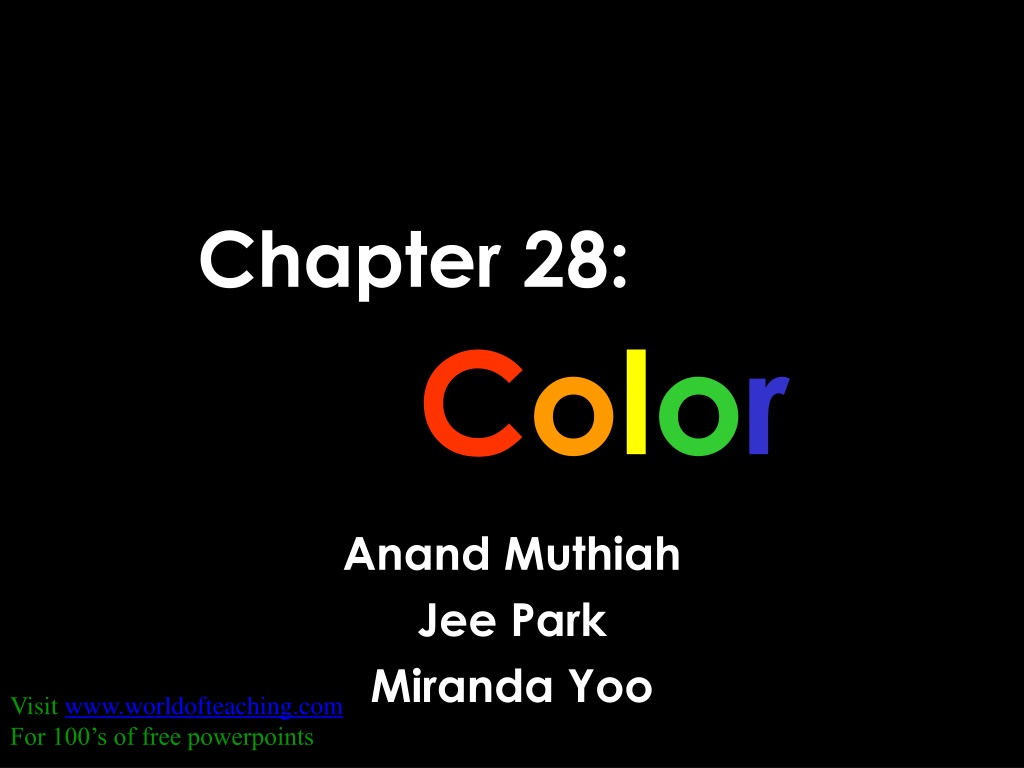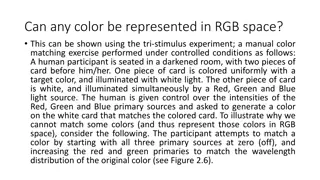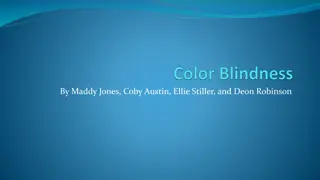Understanding Color: A Comprehensive Overview
Color is a fascinating aspect of our visual world, explored through the prism of science and light. This chapter delves into the origins of color perception, from Isaac Newton's study of the color spectrum to the reflection and transmission of light that determines how we see colors. Gain insights into the properties of white light, the role of molecules in color reflection, and the subjective nature of color perception based on light sources. Discover the intricate relationship between light, objects, and the vibrant palette of colors that surrounds us.
Download Presentation

Please find below an Image/Link to download the presentation.
The content on the website is provided AS IS for your information and personal use only. It may not be sold, licensed, or shared on other websites without obtaining consent from the author. Download presentation by click this link. If you encounter any issues during the download, it is possible that the publisher has removed the file from their server.
E N D
Presentation Transcript
Chapter 28: Color Anand Muthiah Jee Park Miranda Yoo Visit www.worldofteaching.com For 100 s of free powerpoints
28.1: The Color Spectrum Isaac Newton was the first to make a systematic study of color. He did this by passing a narrow beam of sunlight through a triangular-shaped glass prism His method showed that sunlight is composed of a mixture of all the colors of the rainbow. This selection of colors is called a spectrum: red, orange, yellow, green, blue, and violet.
28.1: cont True colors- Newton showed that colors in the spectrum were a property of white light. All the colors added together make white. Black is not considered a true color, but it is the absence of light. Objects that are black absorb all other light frequencies. You can see black objects because they cannot absorb all the light, otherwise you would not be able to see the object.
28.1: cont Sunlight is an example of white light. Under white light objects that are white will appear white and objects that are colored will show their color
28.2:Color by Reflection Objects are a certain color because of the light they reflect. (Ex. Red objects are red because they reflect red light.) Molecules are made up of atoms. Atoms contain protons and neutrons. The electrons orbit the nucleus of the atom. These electrons can be excited to higher states and can send out energy waves.
28.2: cont Different elements have different frequencies for absorbing and emitting radiation. Reflection is when light is bounced back to the source from where it came. When something is transparent the light is not bounced back, but simply transmitted through.
28.2: cont An object can reflect only light of the frequencies present in the illuminating light. The appearance of a colored object therefore depends on the kind of light used to illuminate it. Colors in the daylight appear different from the way they appear when illuminated with manmade lamps. The color seen from an object is subjective and depends on the source of the light.
28.3: Color by Transmission The color of a transparent object depends on the color of the light that is transmits. A piece of blue glass transmits blue light. Pigment is the material in the transparent glass that selectively absorbs colored light.
28.3: cont Electrons in the pigment selectively absorb light of certain frequencies in the illuminating light. Light that is not part of the selective frequencies is reemitted from atom to atom in the glass. Ordinary window glass is colorless and it transmits all colors and visible frequencies of light.
28.4: Sunlight The light from the sun is a composite of all the visible frequencies. The color frequencies have uneven brightness. Yellow-green light is the brightest part of sunlight, (the most heat).
28.4: cont The human eye is most sensitive to yellow- green, which is why more new fire engines are painted this color; it attracts attention easier. Yellow- green is also easy to see at night because of their illuminating properties
28.5 Mixing Colored Light When red, blue, and green light are projected onto a screen, the overlapping areas appear different colors. Where all the three overlap, white is produced. RED + GREEN =YELLOW RED+ BLUE = MAGENTA GREEN + BLUE = CYAN Additiveprimary colors are red, blue, and green because these colors produce the highest number of different colors..
28.6: Complementary Colors When two colors are added together to produce white, they are called complementary colors. YELLOW + BLUE =WHITE ( Yellow a combination of Green + Red ) MAGENTA + GREEN = WHITE ( Magenta a combination of red + blue) CYAN + RED = WHITE ( Cyan a combination of green+ blue)
28.6: cont For example : if white light falls on a pigment that absorbs red light, the light reflected appears cyan. Not all light incident upon an object is reflected. The ones that are absorbed are subtracted from the incident light. Whenever you subtract a color from white light, you end up with the complementary color.
27.7 Mixing Colored Pigments -Mixing red, green, and blue paint is entirely different from the mixing of colored light. -Pigments absorb light of a relatively wide range of frequencies. -Subtractive primary colors are three paint or dye colors that are more useful in color mixing by subtraction are MAGENTA, YELLOW, and CYAN
Blue pigment reflects not only blue light, but also colors to either side of blue namely, green and violet. It absorbs red orange and yellow light. Blue Red , orange, and yellow have been subtracted from the incident light. BLUE <date/time> <footer>
28.8 Why the Sky is Blue Nitrogen and oxygen molecules ring like tiny bells with high frequency when energized by sunlight. Incident Beam Atom Reemit light in all directions like the sound of a bell. Scattered Radiation
28.8: cont Ultraviolet light from the sun is absorbed by the protective layer of the ozone gas. Visible frequencies of violet light is scattered. Although the violet light is scattered more, our eyes are only sensitive to blue. That s why we see a blue sky.
28.9: cont Lower frequencies of light are scattered the least by nitrogen and oxygen molecules Red, orange, yellow are transmitted more readily through the atmosphere Light of lower frequencies is transmitted while light of higher frequencies are scattered
28.9: cont At dawn and sunset, the sunlight reaches the earth at a longer path At noon, the light travels the least Blue light is scattered as the path of the sunlight becomes longer
28.10: Why Water is Greenish Blue Water is transparent to almost all the visible frequencies of light. The color is actually the reflected color of the sky Red is absorbed by the molecules in the water
28.11: The Atomic Color Code- Atomic Spectra Every element has its own specific glow The light from the elements can be analyzed by a spectroscope It is composed of thin slits, lenses, and a prism It displays the spectrum of light Line spectrum- images of the slit through which the light passes























